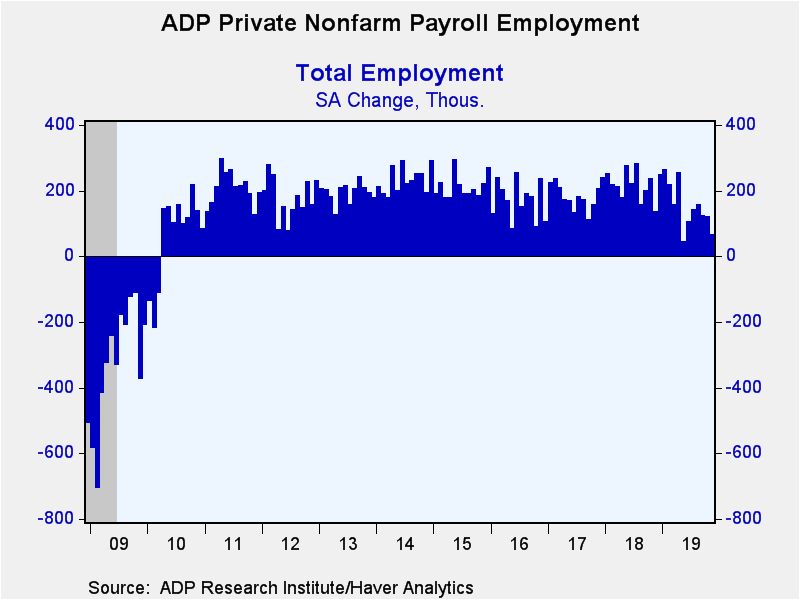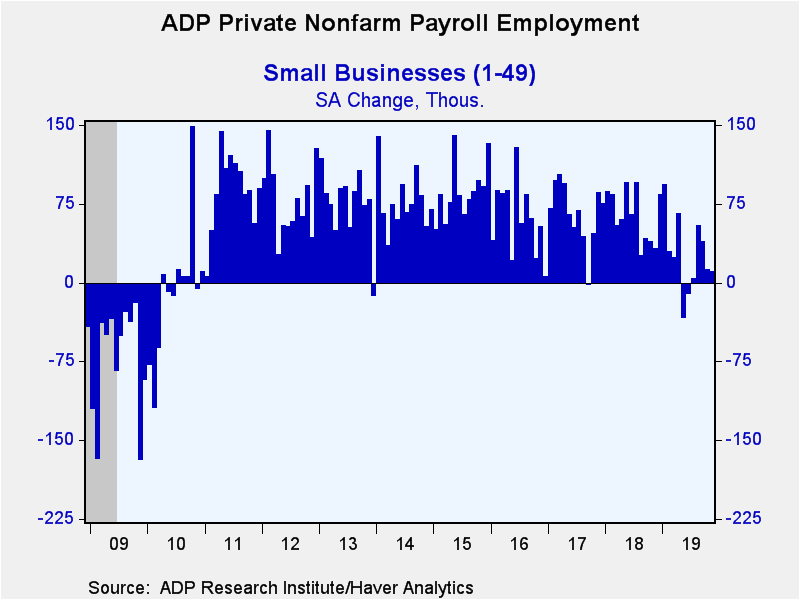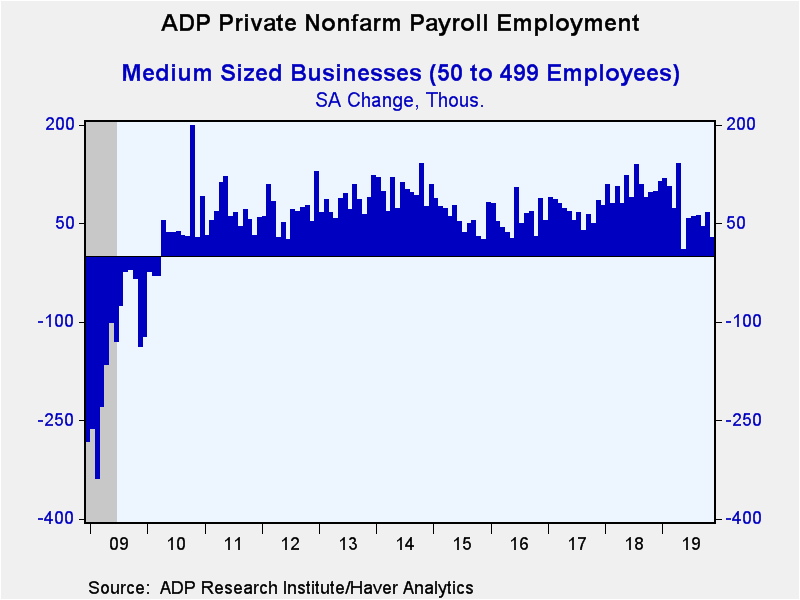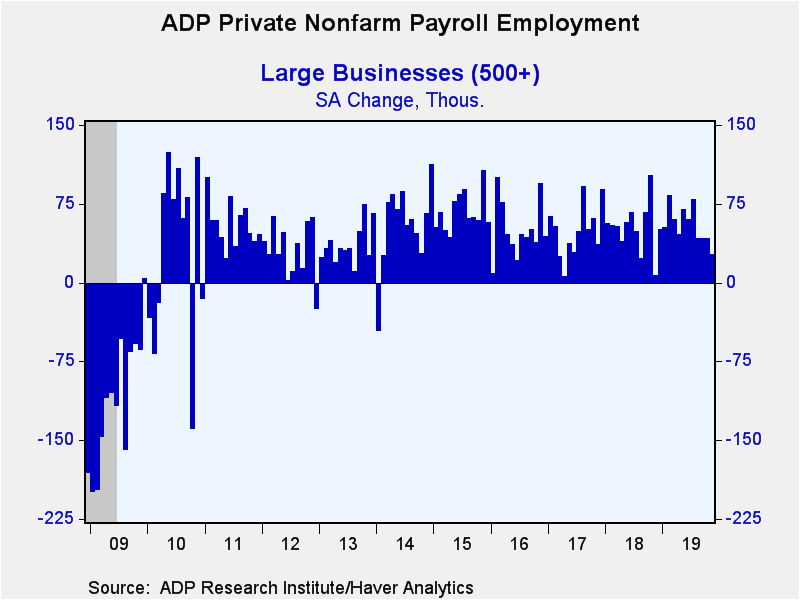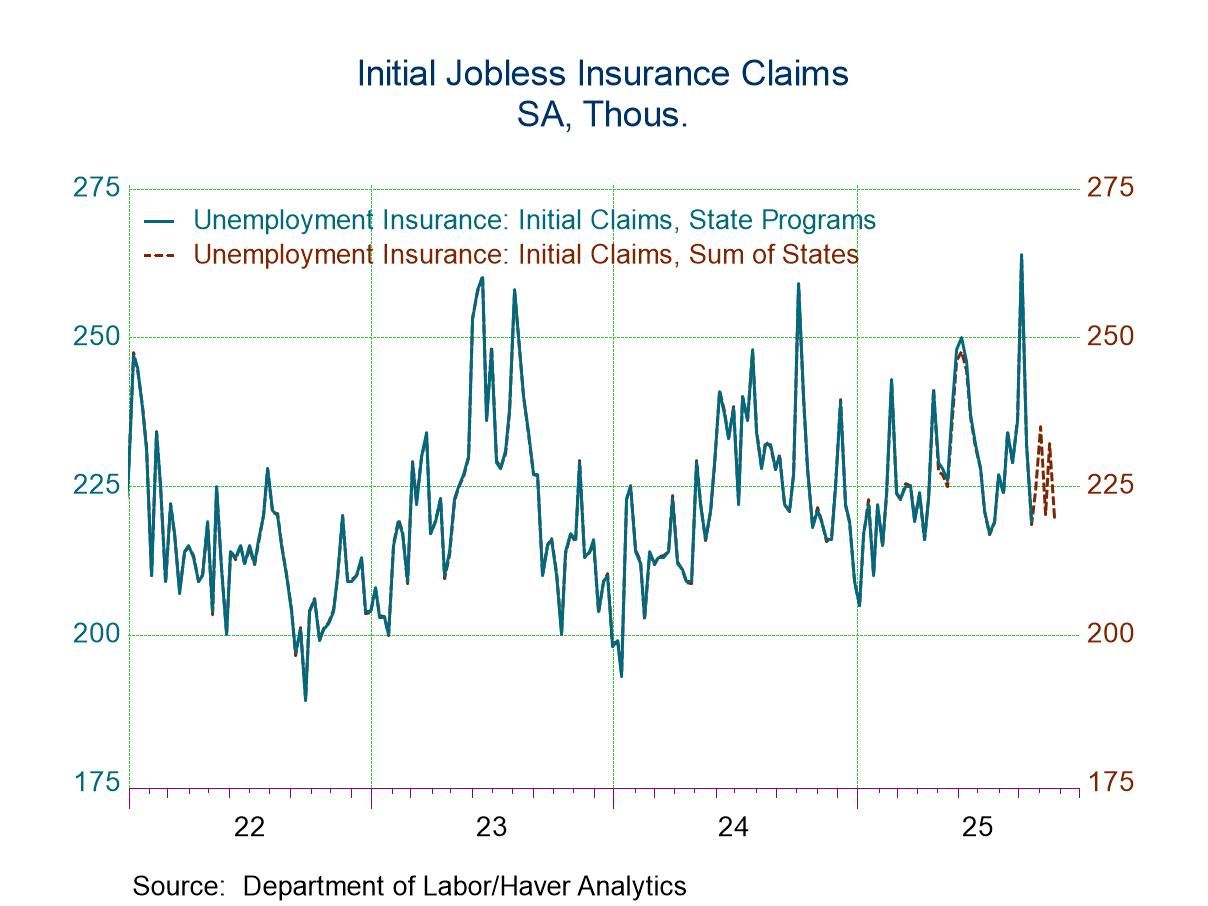 Global| Dec 04 2019
Global| Dec 04 2019U.S. ADP Private Payroll Increase Disappoints
by:Tom Moeller
|in:Economy in Brief
Summary
The ADP National Employment Report indicated that private nonfarm payrolls rose 67,000 (1.5% y/y) during November following a 121,000 October increase, revised from 125,000. The gain fell below expectations for a 140,000 rise in the [...]
The ADP National Employment Report indicated that private nonfarm payrolls rose 67,000 (1.5% y/y) during November following a 121,000 October increase, revised from 125,000. The gain fell below expectations for a 140,000 rise in the Action Economics Forecast Survey. During the last three months, payrolls rose an average 104,000 per month. That compared to a high of 260,000 in July of last year.
The increase in small payrolls remained weak, posting an 11,000 rise (0.7% y/y), the smallest gain since July. The average three-month rise of 21,000 was one-quarter of the growth early last year. Medium sized payrolls rose a lessened 29,000 (1.9% y/y), leaving three-month growth of 47,000 comparing to 113,000 as of February. Large-sized payrolls increased 27,000 (2.3% y/y), the weakest increase in twelve months. The 37,000 average rise during the last three months compares to 70,000 as of July.
Within industry sectors, employment at goods-producing firms fell 18,000 (+0.8% y/y) during November, the sixth decline in the last seven months. Payrolls here have declined on average 11,000 per month since September. Factory sector employment weakened 6,000 last month (+0.3% y/y). The three-month average decline of 5,000 compares to the March 2018 three-month high of 25,000. Construction sector payrolls also fell 6,000 last month (+2.1% y/y). The three-month average decline of 2,000 stands in contrast to +39,000 as of this past February. Employment in the natural resource & mining sector declined 6,000 (-3.7% y/y) and has been falling since March.
Employment growth in the private-service sector moderated to 85,000 last month (+1.0% y/y) after a 135,000 October rise. It was the weakest increase in six months and left average three-month of 115,000 contrasting to 196,000 as of July 2018. Trade, transportation & utilities payrolls declined 15,000 (+0.6% y/y) after a 25,000 October increase. Information sector payrolls were off 8,000 (-0.2% y/y) following two months of modest increase. Education & health service sector payrolls increased 39,000 and a fairly steady 2.4% y/y, though recent increases have moderated. Professional & business sector job increased 28,000 (2.1% y/y), less than half the three-month average gain as of April. The number of leisure & hospitality jobs grew 18,000 (2.0% y/y). Three-month growth moderated to 23,000, down from 42,000 in January. Payrolls in finance increased a fairly steady 11,000 (1.4% y/y).
The Automatic Data Processing Research Institute survey is based on ADP's business payroll transaction system covering 411,000 companies and nearly 24 million employees. The data are processed by Moody's Analytics Inc., then calibrated and aligned with the BLS establishment survey data. The ADP data cover private sector employment only.
The ADP National Employment Report data can be found in Haver's USECON database. Historical figures date back to 2001 for private employment and the industry breakdown, and 2005 for the business size breakout. The expectation figure is available in Haver's AS1REPNA database.
| ADP/Moody's National Employment Report | Nov | Oct | Sep | Nov Y/Y | 2018 | 2017 | 2016 |
|---|---|---|---|---|---|---|---|
| Nonfarm Private Payroll Employment (m/m chg, 000s) | 67 | 121 | 124 | 1.5 | 2.0 | 1.7 | 2.0 |
| Small Payroll (1-49) | 11 | 12 | 39 | 0.7 | 1.5 | 1.5 | 1.9 |
| Medium Payroll (50-499) | 29 | 68 | 44 | 1.9 | 2.3 | 1.8 | 1.5 |
| Large Payroll (>500) | 27 | 42 | 42 | 2.3 | 2.3 | 2.1 | 2.7 |
| Goods-Producing | -18 | -13 | -1 | 0.8 | 3.1 | 1.7 | 0.8 |
| Construction | -6 | -3 | 4 | 2.1 | 5.0 | 3.3 | 4.3 |
| Manufacturing | -6 | -7 | -2 | 0.3 | 1.8 | 0.8 | 0.1 |
| Service-Producing | 85 | 135 | 126 | 1.0 | 1.7 | 1.8 | 2.2 |
Tom Moeller
AuthorMore in Author Profile »Prior to joining Haver Analytics in 2000, Mr. Moeller worked as the Economist at Chancellor Capital Management from 1985 to 1999. There, he developed comprehensive economic forecasts and interpreted economic data for equity and fixed income portfolio managers. Also at Chancellor, Mr. Moeller worked as an equity analyst and was responsible for researching and rating companies in the economically sensitive automobile and housing industries for investment in Chancellor’s equity portfolio. Prior to joining Chancellor, Mr. Moeller was an Economist at Citibank from 1979 to 1984. He also analyzed pricing behavior in the metals industry for the Council on Wage and Price Stability in Washington, D.C. In 1999, Mr. Moeller received the award for most accurate forecast from the Forecasters' Club of New York. From 1990 to 1992 he was President of the New York Association for Business Economists. Mr. Moeller earned an M.B.A. in Finance from Fordham University, where he graduated in 1987. He holds a Bachelor of Arts in Economics from George Washington University.


